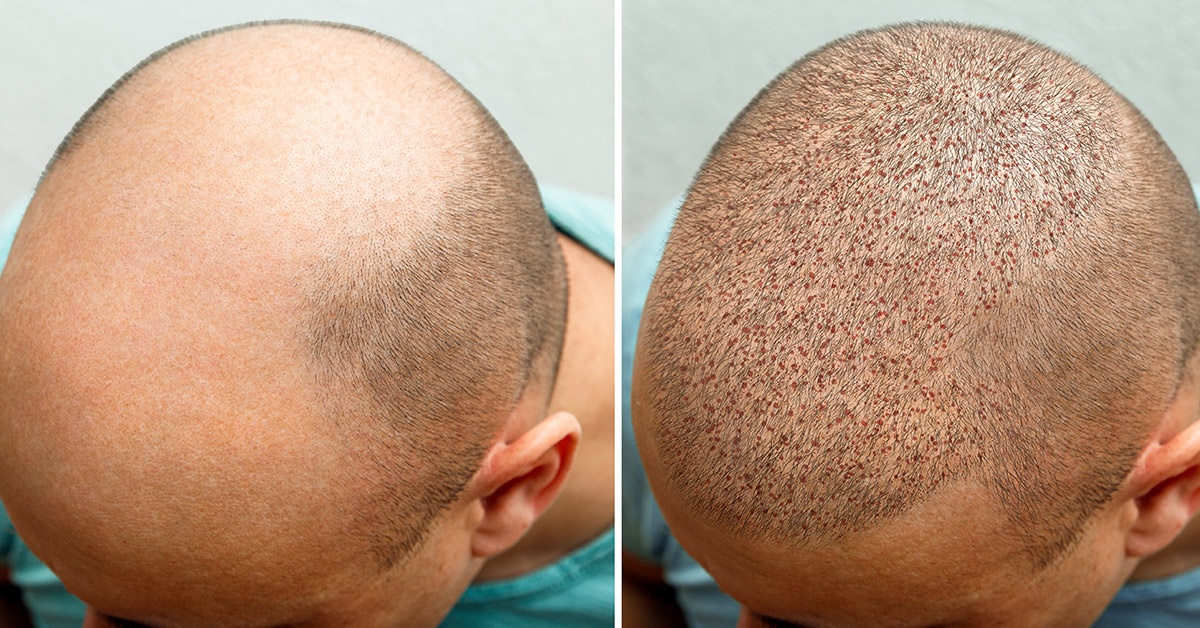Hair Transplant Recovery Process
When considering a hair transplant procedure, you’re often excited about the result – permanently improving your experience. Why wouldn’t you be? Hair transplants often provide a fuller head of hair.
However, a hair transplant is a surgical procedure, so you probably have questions about post-op recovery. Here we share everything you need to know about your hair transplant recovery process.

How Does a Hair Transplant Work?
The one-day outpatient procedure is performed with a local anesthetic. Hair follicles are transplanted into your scalp using either the follicular unit transplantation or follicular unit extraction/excision procedure.

What to Expect Right After My Hair Transplant
Immediately following your surgery, there will be scalp tenderness. Pain medications will help with this. You will have bandages on your scalp for a couple of days, and there may be antibiotics or anti-inflammatories prescribed for the first several days. But you should be able to return to work within a week.
These first days and weeks after your surgery are essential for healing. You will begin to see new hair growth in the first few months, with full natural hair growth in about ten months. For the first few days, it’s important to follow any aftercare instructions given to you by your surgeon, including getting plenty of rest, as it will help to speed your recovery.
You will want to avoid swimming, alcohol consumption, smoking, and vigorous exercise. Within the first fourteen days, avoid wearing baseball caps and hard hats. Don’t use any hair products or hair dryers.
About a week after your surgery, you can begin to wash it, but be gentle and avoid using shampoo. Your swelling and tenderness should be mostly gone. You will still want to hold off on high-impact exercises.
Two weeks post-op, your scalp will appear to be scabbed. This is normal as long as there is no pain accompanying the scabbing. Your new hair will shed away, but this is a part of the process.
You can wash your hair normally as you did before your surgery at this stage with a gentle shampoo. Let your hair dry naturally, patting it gently with a clean towel if needed. You may begin to exercise at this point but discuss your activities with your physician.
Your incisions should have fully healed within three to six months, and your hair will start to grow naturally. You should be checking up with your physician at this point.
How Long Does it Take for Hair Transplant Recovery?
The recovery time from a hair transplant recovery process will vary from patient to patient. Surgery recovery time will be about fourteen days. You will have to avoid strenuous activities and avoid sweating during this time. Your scalp will be delicate right after surgery, and you should not disturb the area.
You should expect some bruising and scabbing during the healing process. You mustn’t try to pick the scabs off. After the first few weeks, you will have a post-op consultation with your surgeon to evaluate the area.
The Stages of Hair Transplant Recovery
The first stage is rest – get lots of rest to alleviate the pain in the scalp. Scabs will start to heal within the first ten days, leading to complete healing in four months.
The second stage is recovering from the pain and tenderness. The first week must be about resting and staying away from high physical stress. The swelling and redness should subside within the first week, but it will take two weeks to heal fully.
You should see some hair growth from the shaft when you get to the three-month mark, and old hair should begin to shed away. This is a good thing.
Eight weeks after surgery, you should be seeing more hair growth from your follicles, and the new hair should be thicker than it was in the last few weeks. At about six to eight months, your hair growth will increase in density; if you need to start styling and coloring your hair, you may do this now
Transplant Recovery Time
The transplant recovery time is different for everyone. You will experience some tenderness, itchiness, and minor pain in the first few weeks, and this can be alleviated with over-the-counter anti-inflammatory drugs. The day after surgery, you may return to work if you don’t perform much physical activity in your position.
Your scalp is just starting to heal, and you should avoid sun exposure. Swelling may develop a couple of days post-op, which will go away in a few days.
Two weeks later, some shafts will shed, and the hair will begin to regrow in later months. Three months after your surgery, you may have a few pimples; use a warm compress.
New hair growth is actively happening in the next four to nine months, and these hairs will be very fine. At the one-year mark, your hair should be fully grown. You must follow instructions given to you by your physician.
Stages of Recovery Vary
After about a week, you will have slight swelling and discomfort that should heal after the first seven days. A couple of weeks after surgery, the new hair will shed away. This is normal, and you will start to see new hair growth at about four months.
The stages of recovery will vary, but if you follow all directions, your recovery will be successful. At first, you will have some inflammation that will last a week or two. During the first week, you should use water. Pour the water, and don’t scrub your scalp. Within about a couple of days, you can return to work as long as you don’t have to do any heavy lifting since the procedure is minimally invasive.
The hair transplant procedure and the recovery period will differ for each patient. But as long as you follow the doctor’s orders, go easy on your scalp, and have patience, your hair transplant will be successful.
Related Articles About Hair Transplant
Learn more about the procedure
